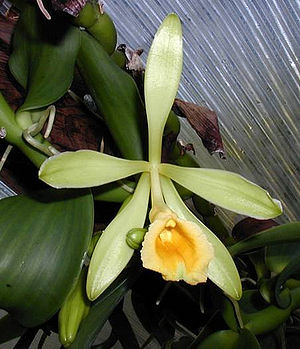Vanilla pompona
| Vanilla pompona | ||||||||||||
|---|---|---|---|---|---|---|---|---|---|---|---|---|

Vanilla pompona |
||||||||||||
| Systematics | ||||||||||||
|
||||||||||||
| Scientific name | ||||||||||||
| Vanilla pompona | ||||||||||||
| Differ |
Vanilla pompona also known as small vanilla or (due to its shape) banana vanilla , is a type of plant from the genus vanilla ( Vanilla ) in the orchid family (Orchidaceae). The climbing plant is found in Central America.
description
Vanilla pompona is an evergreen climber. The stem axis is green, fleshy, round in cross section with a diameter of 1 to 1.5 centimeters. The leaves are elongated oval, they end pointedly at the front, the leaf base is abruptly narrowed to slightly heart-shaped, the petiole is 1 centimeter long and just as wide. The leaf length is 15 to 25 centimeters, the width 5 to 12 centimeters. The top of the leaves is glossy dark green, the underside is lighter and more matte. The leaves are leathery to fleshy (0.3 to 0.5 centimeters thick), the leaf margin is somewhat translucent and sharply edged.
The inflorescence axis becomes 2 to 5 centimeters long and bears six to eight large, lemony-scented flowers. The bracts are arranged in two rows, wide to narrow oval shaped, 1 to 2 centimeters long. The curved ovary is 5 to 6 inches long and slightly triangular in cross section. The sepals and lateral petals are lanceolate, widest above the middle, they end blunt, their length is 7.5 to 8.5 centimeters with 1.2 to 1.6 centimeters wide. The petals are slightly shorter than the outer petals, their edges can be slightly wavy, on the outside they are keeled. The lip is 9 to 9.5 centimeters long, unlobed or indicated three-lobed. Its edges are turned up and form a tube, only the front part is spread out and curled at the edge. The surface of the lip is smooth except for a clump of hair directed backwards. The column is 6 to 7 centimeters long, half of its length it is fused with the edges of the lip. The slightly curved, sweet aromatic smelling fruit reaches 10 to 12, rarely up to 18 centimeters in length, in cross section it measures 1.6 to 3 centimeters. The seeds are oval, glossy black and 0.4 millimeters in size.
The number of chromosomes is 2n = 32.
distribution
Vanilla pompona has been found from Mexico, Nicaragua , Costa Rica and Panama, possibly also populations from Ecuador and Colombia. The distribution in northern South America is unclear. Because of its aromatic fruits, it is occasionally grown, especially in the Caribbean ( Guadeloupe , Antilles ) but also in Madagascar . In terms of cultivation, it is not as sensitive as the spiced vanilla ( Vanilla planifolia ) and it takes a short time to bear fruit.
Systematics and botanical history
This orchid was described by Schiede in 1829 .
Within the genus Vanilla , Vanilla pompona is classified in the subgenus Xanata and there in the section Xanata , which only contains species of the Neotropics . Soto Arenas and Cribb classify a number of other species in the so-called Vanilla pompona group, these are Vanilla calyculata , Vanilla chamissonis , Vanilla columbiana , Vanilla grandiflora , Vanilla pseudopompona and Vanilla vellozii .
Three subspecies can be distinguished within Vanilla pompona :
- Vanilla pompona subsp. pompona , the nominate form , has a distribution area in Mexico that is separated from the other populations further south. The flowers are relatively small and do not open wide.
- Vanilla pompona subsp. grandiflora (Lindl.) Soto Arenas from the area between Trinidad and tropical South America has, as the name suggests, larger flowers that open wide.
- Vanilla pompona subsp. pittieri (Schltr.) Dressler from Honduras, Nicaragua, Costa Rica and Panama.
literature
- Le Vanillier et la Vanille dans le Monde . In: Gilbert Bouriquet (ed.): Encyclopédie Biologique . tape XLVI . Paul Lechevalier, Paris 1954.
Individual evidence
- ↑ a b Roland Portères: Le Genre Vanilla et ses Espèces. In: Le Vanillier et la Vanille dans le Monde. Pp. 222-223.
- ^ Tropicos. [1]
- ↑ a b Miguel A. Soto Arenas, Phillip Cribb: A new infrageneric classification and synopsis of the genus Vanilla Plum. ex Mill. (Orchidaceae: Vanillinae) . In: Lankesteriana . tape 9 , no. 3 , 2010, p. 385 ( ucr.ac.cr [PDF; 692 kB ]).
- ^ A b Miguel A. Soto Arenas, Robert Dressler: A revision of the Mexican and Central American species of Vanilla Plumier ex Miller with a characterization of their ITS region of the nuclear ribosomal DNA . In: Lankesteriana . tape 9 , no. 3 , 2010, p. 336 ( ucr.ac.cr [PDF; 3.5 MB ]).
- ↑ Alec M. Pridgeon, Phillip Cribb, Mark W. Chase, Finn Rasmussen (eds.): Genera Orchidacearum. tape 3 : Orchidoideae , Part 2: Vanilloideae . Oxford University Press, New York / Oxford 2003, ISBN 0-19-850711-9 , pp. 331 .
- ↑ In: Linnaea. Volume 4, 1829, p. 573.
- ↑ a b c d e Rafaël Govaerts (Ed.): Vanilla pompona. In: World Checklist of Selected Plant Families (WCSP) - The Board of Trustees of the Royal Botanic Gardens, Kew . Retrieved May 20, 2020.